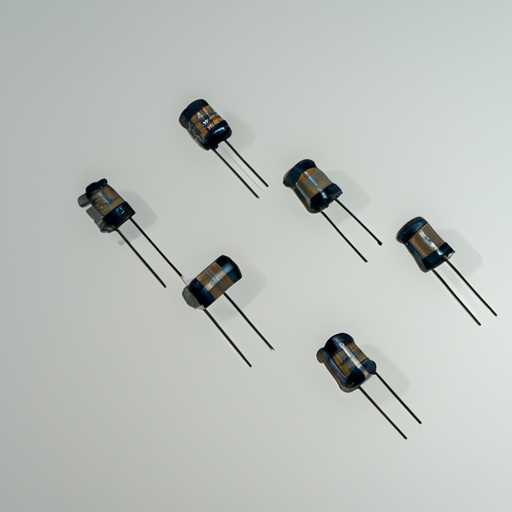The Role of High-Power Resistor Products in Practical Applications
I. Introduction
High-power resistors are essential components in electrical and electronic circuits, designed to handle significant amounts of power while maintaining their functionality and reliability. These resistors play a crucial role in various applications, from power electronics to telecommunications, ensuring that systems operate efficiently and safely. In this blog post, we will explore the characteristics, types, applications, and future trends of high-power resistors, highlighting their importance in modern technology.
II. Understanding High-Power Resistors
A. Characteristics of High-Power Resistors
High-power resistors are defined by several key characteristics:
1. **Power Rating**: This refers to the maximum amount of power a resistor can dissipate without overheating. High-power resistors typically have power ratings ranging from a few watts to several kilowatts, making them suitable for demanding applications.
2. **Resistance Value**: The resistance value determines how much current will flow through the resistor for a given voltage. High-power resistors come in a wide range of resistance values, allowing for flexibility in circuit design.
3. **Tolerance and Temperature Coefficient**: Tolerance indicates how much the actual resistance can vary from the specified value, while the temperature coefficient describes how the resistance changes with temperature. High-power resistors are designed to maintain stability under varying conditions.
B. Types of High-Power Resistors
There are several types of high-power resistors, each with unique properties suited for specific applications:
1. **Wirewound Resistors**: These resistors are made by winding a wire around a core, providing excellent power handling and stability. They are commonly used in applications requiring high precision and reliability.
2. **Thick Film Resistors**: Constructed by applying a thick layer of resistive material onto a substrate, thick film resistors are known for their compact size and cost-effectiveness. They are widely used in consumer electronics.
3. **Thin Film Resistors**: Similar to thick film resistors but with a thinner layer of resistive material, thin film resistors offer higher precision and stability, making them ideal for high-frequency applications.
4. **Ceramic Resistors**: These resistors are made from ceramic materials, providing excellent thermal stability and resistance to environmental factors. They are often used in high-temperature applications.
C. Materials Used in High-Power Resistors
The performance of high-power resistors is influenced by the materials used in their construction:
1. **Conductive Materials**: Common conductive materials include metal alloys for wirewound resistors and conductive inks for thick and thin film resistors. The choice of material affects the resistor's power rating and stability.
2. **Insulating Materials**: Insulation is crucial for preventing short circuits and ensuring safety. High-quality insulating materials, such as ceramics and polymers, are used to enhance the durability and performance of high-power resistors.
III. Applications of High-Power Resistors
High-power resistors find applications across various industries, each leveraging their unique properties:
A. Power Electronics
In power electronics, high-power resistors are vital components in devices such as inverters and converters. They help manage power flow, ensuring efficient energy conversion and distribution. Additionally, they are used in motor drives to control the speed and torque of electric motors.
B. Industrial Applications
High-power resistors are commonly used in load banks and test equipment in industrial settings. Load banks simulate electrical loads for testing generators and other power sources, while test equipment relies on high-power resistors to ensure accurate measurements and performance evaluations.
C. Automotive Applications
The automotive industry increasingly relies on high-power resistors, particularly in electric vehicles (EVs) and hybrid systems. These resistors are used in battery management systems, regenerative braking, and power distribution, contributing to the overall efficiency and performance of modern vehicles.
D. Renewable Energy Systems
High-power resistors play a crucial role in renewable energy systems, such as solar inverters and wind turbine systems. They help manage power conversion and ensure stable operation, enabling the integration of renewable energy sources into the grid.
E. Telecommunications
In telecommunications, high-power resistors are used in signal processing and RF applications. They help manage signal levels, ensuring clear communication and preventing signal distortion.
IV. The Role of High-Power Resistors in Circuit Design
High-power resistors serve several critical functions in circuit design:
A. Current Limiting
High-power resistors are often used to limit the current flowing through a circuit, protecting sensitive components from damage due to excessive current.
B. Voltage Division
In voltage divider circuits, high-power resistors help distribute voltage levels, allowing for the safe operation of various components within a system.
C. Signal Attenuation
High-power resistors can attenuate signals, reducing their amplitude to prevent distortion and ensure accurate signal processing.
D. Thermal Management
Effective thermal management is essential in high-power applications. High-power resistors dissipate heat generated during operation, preventing overheating and ensuring reliability.
E. Safety and Protection
High-power resistors contribute to the safety of electrical systems by providing overcurrent protection and preventing voltage spikes that could damage components.
V. Challenges and Considerations
While high-power resistors are invaluable in many applications, several challenges must be addressed:
A. Heat Dissipation and Thermal Management
High-power resistors generate significant heat during operation, necessitating effective thermal management solutions. Proper heat sinks and cooling systems are essential to maintain performance and reliability.
B. Selection Criteria for High-Power Resistors
When selecting high-power resistors, engineers must consider various factors, including power rating, resistance value, and environmental conditions. Ensuring that the chosen resistor meets application requirements is crucial for optimal performance.
C. Reliability and Lifespan
The reliability and lifespan of high-power resistors are critical considerations, especially in mission-critical applications. Engineers must choose resistors with proven durability and performance under varying conditions.
D. Cost Considerations
While high-power resistors are essential, cost can be a significant factor in their selection. Engineers must balance performance requirements with budget constraints to ensure cost-effective solutions.
VI. Future Trends and Innovations
The field of high-power resistors is evolving, with several trends and innovations shaping their future:
A. Advances in Materials and Technology
Ongoing research into new materials and manufacturing techniques is leading to the development of high-power resistors with improved performance and reliability. These advancements may include the use of nanomaterials and advanced ceramics.
B. Miniaturization and Integration in Circuits
As electronic devices become smaller and more compact, the demand for miniaturized high-power resistors is increasing. Innovations in design and manufacturing will enable the integration of high-power resistors into smaller circuit boards.
C. Smart Resistors and IoT Applications
The rise of the Internet of Things (IoT) is driving the development of smart resistors capable of monitoring and adjusting their performance in real-time. These resistors can enhance the efficiency and functionality of connected devices.
D. Sustainability and Eco-Friendly Designs
As environmental concerns grow, there is a push for sustainable and eco-friendly designs in the electronics industry. High-power resistors made from recyclable materials and designed for energy efficiency will play a crucial role in this trend.
VII. Conclusion
High-power resistors are indispensable components in a wide range of applications, from power electronics to telecommunications. Their ability to handle significant power while maintaining stability and reliability makes them essential for modern technology. As we look to the future, advancements in materials, miniaturization, and smart technologies will continue to shape the role of high-power resistors in practical applications. Understanding their importance and functionality will enable engineers and designers to create more efficient and reliable systems, ultimately driving innovation in the electronics industry.
VIII. References
- Academic journals on electrical engineering and materials science.
- Industry publications focusing on power electronics and resistor technology.
- Technical manuals and datasheets from leading resistor manufacturers.
The Role of High-Power Resistor Products in Practical Applications
I. Introduction
High-power resistors are essential components in electrical and electronic circuits, designed to handle significant amounts of power while maintaining their functionality and reliability. These resistors play a crucial role in various applications, from power electronics to telecommunications, ensuring that systems operate efficiently and safely. In this blog post, we will explore the characteristics, types, applications, and future trends of high-power resistors, highlighting their importance in modern technology.
II. Understanding High-Power Resistors
A. Characteristics of High-Power Resistors
High-power resistors are defined by several key characteristics:
1. **Power Rating**: This refers to the maximum amount of power a resistor can dissipate without overheating. High-power resistors typically have power ratings ranging from a few watts to several kilowatts, making them suitable for demanding applications.
2. **Resistance Value**: The resistance value determines how much current will flow through the resistor for a given voltage. High-power resistors come in a wide range of resistance values, allowing for flexibility in circuit design.
3. **Tolerance and Temperature Coefficient**: Tolerance indicates how much the actual resistance can vary from the specified value, while the temperature coefficient describes how the resistance changes with temperature. High-power resistors are designed to maintain stability under varying conditions.
B. Types of High-Power Resistors
There are several types of high-power resistors, each with unique properties suited for specific applications:
1. **Wirewound Resistors**: These resistors are made by winding a wire around a core, providing excellent power handling and stability. They are commonly used in applications requiring high precision and reliability.
2. **Thick Film Resistors**: Constructed by applying a thick layer of resistive material onto a substrate, thick film resistors are known for their compact size and cost-effectiveness. They are widely used in consumer electronics.
3. **Thin Film Resistors**: Similar to thick film resistors but with a thinner layer of resistive material, thin film resistors offer higher precision and stability, making them ideal for high-frequency applications.
4. **Ceramic Resistors**: These resistors are made from ceramic materials, providing excellent thermal stability and resistance to environmental factors. They are often used in high-temperature applications.
C. Materials Used in High-Power Resistors
The performance of high-power resistors is influenced by the materials used in their construction:
1. **Conductive Materials**: Common conductive materials include metal alloys for wirewound resistors and conductive inks for thick and thin film resistors. The choice of material affects the resistor's power rating and stability.
2. **Insulating Materials**: Insulation is crucial for preventing short circuits and ensuring safety. High-quality insulating materials, such as ceramics and polymers, are used to enhance the durability and performance of high-power resistors.
III. Applications of High-Power Resistors
High-power resistors find applications across various industries, each leveraging their unique properties:
A. Power Electronics
In power electronics, high-power resistors are vital components in devices such as inverters and converters. They help manage power flow, ensuring efficient energy conversion and distribution. Additionally, they are used in motor drives to control the speed and torque of electric motors.
B. Industrial Applications
High-power resistors are commonly used in load banks and test equipment in industrial settings. Load banks simulate electrical loads for testing generators and other power sources, while test equipment relies on high-power resistors to ensure accurate measurements and performance evaluations.
C. Automotive Applications
The automotive industry increasingly relies on high-power resistors, particularly in electric vehicles (EVs) and hybrid systems. These resistors are used in battery management systems, regenerative braking, and power distribution, contributing to the overall efficiency and performance of modern vehicles.
D. Renewable Energy Systems
High-power resistors play a crucial role in renewable energy systems, such as solar inverters and wind turbine systems. They help manage power conversion and ensure stable operation, enabling the integration of renewable energy sources into the grid.
E. Telecommunications
In telecommunications, high-power resistors are used in signal processing and RF applications. They help manage signal levels, ensuring clear communication and preventing signal distortion.
IV. The Role of High-Power Resistors in Circuit Design
High-power resistors serve several critical functions in circuit design:
A. Current Limiting
High-power resistors are often used to limit the current flowing through a circuit, protecting sensitive components from damage due to excessive current.
B. Voltage Division
In voltage divider circuits, high-power resistors help distribute voltage levels, allowing for the safe operation of various components within a system.
C. Signal Attenuation
High-power resistors can attenuate signals, reducing their amplitude to prevent distortion and ensure accurate signal processing.
D. Thermal Management
Effective thermal management is essential in high-power applications. High-power resistors dissipate heat generated during operation, preventing overheating and ensuring reliability.
E. Safety and Protection
High-power resistors contribute to the safety of electrical systems by providing overcurrent protection and preventing voltage spikes that could damage components.
V. Challenges and Considerations
While high-power resistors are invaluable in many applications, several challenges must be addressed:
A. Heat Dissipation and Thermal Management
High-power resistors generate significant heat during operation, necessitating effective thermal management solutions. Proper heat sinks and cooling systems are essential to maintain performance and reliability.
B. Selection Criteria for High-Power Resistors
When selecting high-power resistors, engineers must consider various factors, including power rating, resistance value, and environmental conditions. Ensuring that the chosen resistor meets application requirements is crucial for optimal performance.
C. Reliability and Lifespan
The reliability and lifespan of high-power resistors are critical considerations, especially in mission-critical applications. Engineers must choose resistors with proven durability and performance under varying conditions.
D. Cost Considerations
While high-power resistors are essential, cost can be a significant factor in their selection. Engineers must balance performance requirements with budget constraints to ensure cost-effective solutions.
VI. Future Trends and Innovations
The field of high-power resistors is evolving, with several trends and innovations shaping their future:
A. Advances in Materials and Technology
Ongoing research into new materials and manufacturing techniques is leading to the development of high-power resistors with improved performance and reliability. These advancements may include the use of nanomaterials and advanced ceramics.
B. Miniaturization and Integration in Circuits
As electronic devices become smaller and more compact, the demand for miniaturized high-power resistors is increasing. Innovations in design and manufacturing will enable the integration of high-power resistors into smaller circuit boards.
C. Smart Resistors and IoT Applications
The rise of the Internet of Things (IoT) is driving the development of smart resistors capable of monitoring and adjusting their performance in real-time. These resistors can enhance the efficiency and functionality of connected devices.
D. Sustainability and Eco-Friendly Designs
As environmental concerns grow, there is a push for sustainable and eco-friendly designs in the electronics industry. High-power resistors made from recyclable materials and designed for energy efficiency will play a crucial role in this trend.
VII. Conclusion
High-power resistors are indispensable components in a wide range of applications, from power electronics to telecommunications. Their ability to handle significant power while maintaining stability and reliability makes them essential for modern technology. As we look to the future, advancements in materials, miniaturization, and smart technologies will continue to shape the role of high-power resistors in practical applications. Understanding their importance and functionality will enable engineers and designers to create more efficient and reliable systems, ultimately driving innovation in the electronics industry.
VIII. References
- Academic journals on electrical engineering and materials science.
- Industry publications focusing on power electronics and resistor technology.
- Technical manuals and datasheets from leading resistor manufacturers.













